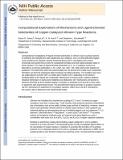Computational Explorations of Mechanisms and Ligand-Directed Selectivities of Copper-Catalyzed Ullmann-Type Reactions
Author(s)
Buchwald, Stephen Leffler; Jones, Gavin O.; Houk, K. N.; Liu, Peng
DownloadBuchwald_Computational Explorations.pdf (2.657Mb)
PUBLISHER_POLICY
Publisher Policy
Article is made available in accordance with the publisher's policy and may be subject to US copyright law. Please refer to the publisher's site for terms of use.
Terms of use
Metadata
Show full item recordAbstract
Computational investigations of ligand-directed selectivities in Ullmann-type coupling reactions of methanol and methylamine with iodobenzene by β-diketone- and 1,10-phenanthroline-ligated CuI complexes are reported. Density functional theory calculations using several functionals were performed on both the nucleophile formation and aryl halide activation steps of these reactions. The origin of ligand-directed selectivities in N- versus O-arylation reactions as described in a previous publication (J. Am. Chem. Soc. 2007, 129, 3490−3491) were studied and explained. The selectivities observed experimentally are derived not from initial CuI(nucleophile) complex formation but from the subsequent steps involving aryl halide activation. The arylation may occur via single-electron transfer (SET) or iodine atom transfer (IAT), depending on the electron-donating abilities of the ligand and nucleophile. Mechanisms involving either oxidative addition/reductive elimination or σ-bond metathesis are disfavored. SET mechanisms are favored in reactions promoted by the β-diketone ligand; N-arylation is predicted to be favored in these cases, in agreement with experimental results. The phenanthroline ligand promotes O-arylation reactions via IAT mechanisms in preference to N-arylation reactions, which occur via SET mechanisms; this result is also in agreement with experimental results.
Date issued
2010-04Department
Massachusetts Institute of Technology. Department of ChemistryJournal
Journal of the American Chemical Society
Publisher
American Chemical Society (ACS)
Citation
Buchwald, Stephen Leffler, et al. "Computational Explorations of Mechanisms and Ligand-Directed Selectivities of Copper-Catalyzed Ullmann-Type Reactions." Journal of the American Chemical Society 132.17 (2010): 6205–6213. Copyright © 2010 American Chemical Society
Version: Author's final manuscript
ISSN
0002-7863
1520-5126